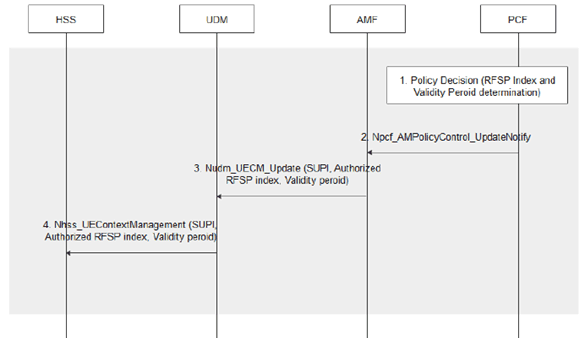Content for TR 23.700-89 Word version: 18.0.0
6.5 Solution #5: Authorized RFSP index provisioning from 5GC to MME without N26 interface
6.5.1 Description
6.5.2 Procedures
6.5.3 Impacts on services, entities and interfaces
...
...
6.5 Solution #5: Authorized RFSP index provisioning from 5GC to MME without N26 interface p. 18
6.5.1 Description p. 18
In the current interworking procedures from 5G to 4G, when the UE moves from 5G to 4G, the PCF should provide the "authorized RFSP index" to the MME.
However, after the UE moves from 5G to 4G, all the UE's context in the 5G side should be released (including the AM policy association for the UE between AMF and PCF), so the PCF cannot update the RFSP index for the UE when it finds that the "authorized RFSP index" is not valid, which resulted in that the MME does not know when it should in turn to use the "subscribed RFSP index" instead of the "authorized RFSP index".
As specified in clause 6.1.1.3 of TS 23.503, PCF may use the network analytics on "Service Experience" for an Application Identifier, "any RAT type" and/or "any Frequency value" to determine the "authorized RFSP index" value for the UE when running this application. Furthermore, as specified in clause 6.4.3 of TS 23.288, the "Service Experience" analytics including a Validity period for the Application service experience analytics. So, it is possible for the PCF to determine the "authorized RFSP index" together with a Validity period.
When N26 interface is not supported, the authorized RFSP index and the Validity period can be provided by the PCF to the UDM/HSS via AMF during the without N26-based interworking procedures, then MME obtains the authorized RFSP index and the Validity period from the HSS.
The MME continues to use the "Authorized RFSP" over the "Subscribed RFSP" during the Validity period. When the Validity period expires, the MME may then send the "Subscribed RFSP" as the RFSP to use to the eNB.
6.5.2 Procedures p. 18
Figure 6.5.2-1 depicts the procedure of propose solution of providing "authorized RFSP index" provisioning from 5GC to MME without N26 interface.

Figure 6.5.2-1: "authorized RFSP index" provisioning from 5GC to MME in without N26-base architecture
(⇒ copy of original 3GPP image)
(⇒ copy of original 3GPP image)
The overall procedure re-uses the 5GS to EPS mobility without N26 interface as defined in TS 23.502. The change is:
- Step 1 and step 2. PCF determines the "authorized RFSP index" together with the Validity period e.g. based on the "Service Experience" analytics from NWDAF and provides these information to AMF.
-
Step 3. If N26 does not apply and the AMF identifies that the "Authorized RFSP index" is different than the "Subscribed RFSP", then the AMF notifies the UDM on the "Authorized RFSP index" and the Validity period received from PCF. If the UDM and HSS are deployed separately then the UDM further notifies the "Authorized RFSP" and the Validity period to the HSS by triggering an Nhss_
UEContextManagement service operation as defined in TS 29.563. In a combined UDM+HSS deployment this step is not needed or handled in implementation specific way. The MME continues to use the "Authorized RFSP index" over the "Subscribed RFSP index" for the Validity period. When the Validity period expires, the MME may then send the "Subscribed RFSP" as the RFSP to use to the eNB.
6.5.3 Impacts on services, entities and interfaces p. 19
The solution has the following impacts:
PCF:
- PCF should determine the "authorized RFSP index" together with the Validity period e.g. based on the "Service Experience" analytics from NWDAF.
- PCF provides the "authorized RFSP index" together with the Validity period to AMF during 5GS to EPS mobility without N26 interface.
- When N26 interface is not supported, AMF provides the "authorized RFSP index" together with the Validity period to UDM during the 5GS to EPS mobility without N26 interface.
- When N26 interface is not supported, UDM receives the "authorized RFSP index" together with the Validity period from AMF during the 5GS to EPS mobility without N26 interface. Optionally, the UDM further provides the "authorized RFSP index" together with the Validity period to HSS when a combined UDM+HSS is not deployed.
- When N26 interface is not supported, MME receives the "authorized RFSP index" together with the Validity period from HSS.
- The MME continues to use the "Authorized RFSP" over the "Subscribed RFSP" for the Validity period. When the Validity period expires, the MME may then send the "Subscribed RFSP" as the RFSP to use to the eNB.